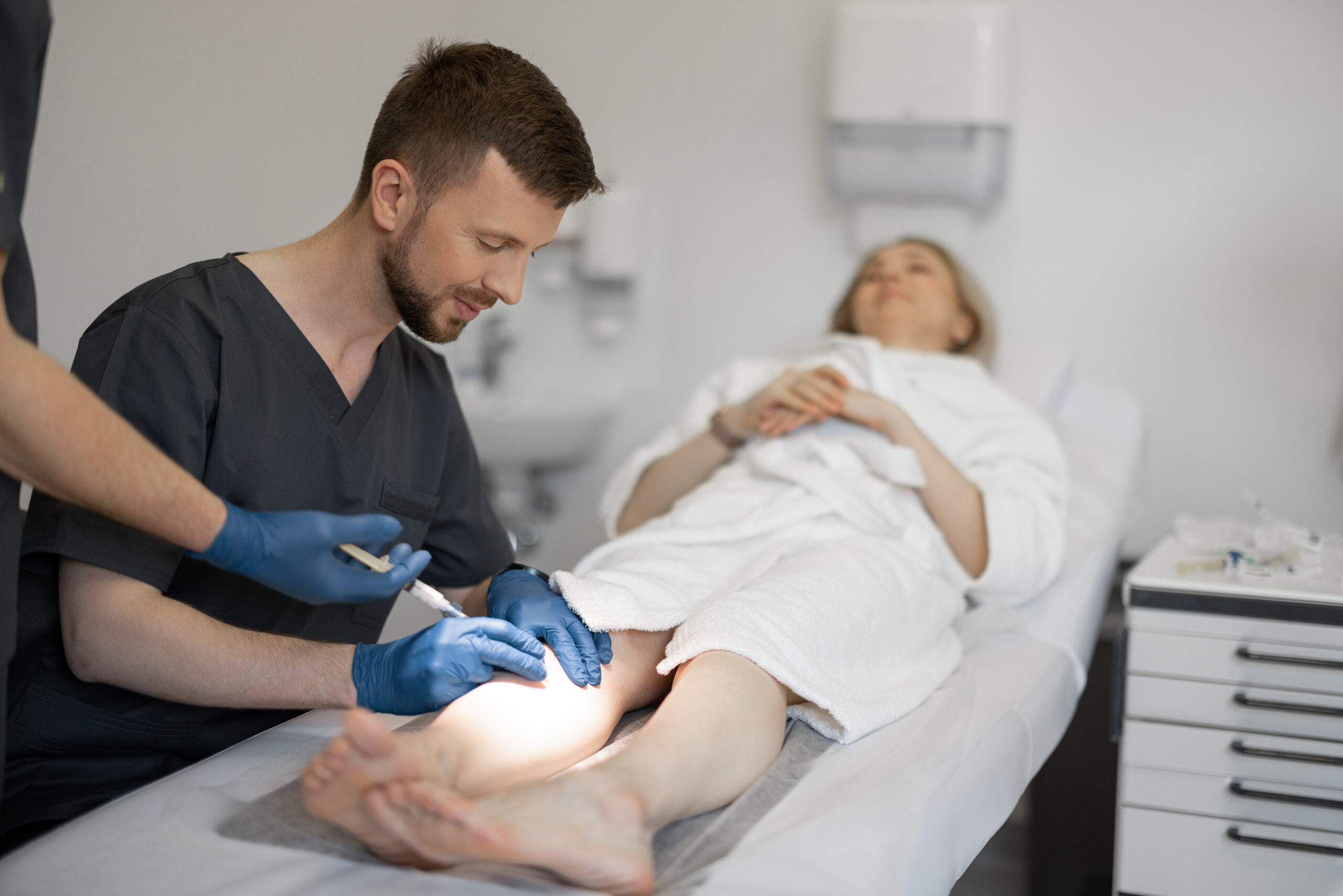Las Vegas’ premier Vein Treatment Center
We provide you with the best options for your vein care.
Using state-of-the-art equipment, knowledge, and experience, we’ll help you achieve the pain-free confidence you deserve. Because every patient is different, we’ll address your individual concerns and design a custom treatment to suit your specific needs.
Thermal ablation
These revolutionary treatments are minimally invasive and designed to treat varicose veins quickly and effectively, with little to no pain. This clinically proven outpatient procedure can get you back on your feet as soon as possible – usually in less than one day.
Our team is experienced and highly skilled in the two different methods of thermal ablation: radiofrequency ablation or endovenous laser treatment. Both vein closure techniques use heat to seal the damaged veins, redirecting the blood flow to other healthy leg veins.
EVLT closure procedure
EVLT stands for endovenous laser treatment – a minimally invasive alternative to surgical stripping that is used to treat damaged veins quickly and effectively.
Before the procedure, the damaged vein path will be mapped out using ultrasound. The patient is placed under oral sedation and a small insertion is made in the leg, usually around the knee area. A catheter is then used to insert laser fiber into the varicose vein. A targeted beam of laser energy helps quickly and safely seal the vein shut, and blood flow is diverted to the surrounding healthy veins. The procedure usually takes about an hour.
After the procedure, you will be encouraged to walk around to get your blood flowing, reducing the risk of complications. Some bruising and swelling may occur, but can be alleviated with the proper use of bandages and compression stockings for one to two weeks after the procedure. Endovenous laser treatment has a 93% success rate, and patients typically resume normal activities within one day.
Ambulatory
This office-based, outpatient surgical procedure is effective for the removal of surface varicose veins. The objective is to completely remove the diseased veins from the body, segment by segment.
Using local or regional anesthesia, the physician creates tiny punctures in the surface of the leg. The damaged veins remain collapsible, and the physician pulls the veins out through tiny incisions that do not require stitches. Your body will divert blood flow to your remaining healthy veins.
After the procedure, you will be able to return home with only a bandage and a compression stocking. Post-operative pain and swelling are generally minimal, especially if the compression stocking is worn as directed – typically one week. Patients may resume normal, non-strenuous activities the same day.
Sclerotherapy
This technique is mainly used to treat spider veins or smaller, surface varicose veins that are less than 1-2mm in diameter. Sclerotherapy is one of the most effective treatments for spider veins.
During the procedure, a sclerosing solution is injected into the vein at various levels. As this irritates the lining of the vein, it swells and sticks together, effectively closing off the vein. This procedure can be uncomfortable for brief periods of time, causing a cramping sensation for one to two minutes.
The entire procedure normally takes 30 to 45 minutes, and multiple sessions may be required. Spider veins typically respond to treatment within one to two weeks. The body eventually absorbs the fibrous tissue of the former vein. With proper use of compression stockings, the patient can return to normal activities the next day.

Vein Disorders
Understanding superficial venous reflux
Your veins perform an essential function in the overall health of your body, as the pathways for deoxygenated blood to travel back to the heart. Your legs hold three types of veins:
- Superficial: This network of veins is located near the surface of the skin and is known as the saphenous vein.
- Deep: Deep veins are the large veins found between the muscles.
- Perforating: Perforating veins act as bridges that carry blood from the saphenous vein to the deep veins of the leg.
Each of these veins plays an important role in the function of your body’s circulatory system.
Venous Reflux Disease Symptoms
Spider veins are small blue or red lines appearing close to the surface of the skin. They can look like thin lines, branching trees or spider webs. Spider veins can appear not only on the legs, but also around the nose and lips. They are not harmful and rarely painful, but they can be unsightly. Patients often choose to have them removed for cosmetic reasons.
Varicose veins
Varicose veins are snake-like, swollen veins occurring on the surface of the skin. Varicose veins are often painful, and while they can be located anywhere on the body, they are typically found in the legs and feet. These damaged veins often cause throbbing, aching and/or burning pain, swelling, itching and heaviness of the leg. Varicose veins are progressive and will worsen if left untreated.
Edema (Leg Swelling)
If varicose veins are not treated in a timely manner, the damaged valves will continue to function improperly, allowing blood and fluid to pool in the leg. This can cause (sometimes extreme) swelling in the leg and ankle, leading to severe discomfort and unsightliness.
Skin changes
Venous reflux disease causes venous hypertension (higher than normal venous blood pressure). The increased pressure often causes fluids and blood to push toward the surface of the skin, resulting in changes in skin texture and color (hyperpigmentation).
Venous ulcers
Venous ulcers occur when inadequate circulation causes the vein to leak, destroying the surface of the skin. This condition is severe and painful, and creates an open, weeping wound that is easily susceptible to infection. These sores, commonly found near the ankle, can take months or even years to heal if venous reflux is left untreated.
The Patient Portal that does it all.
Schedule your appointment. Message your care team. View test results, pay bills, and more. With your secure password, you can log in 24 hours a day, 7 days a week from the comfort and privacy of your home or office. Getting started is simple.
